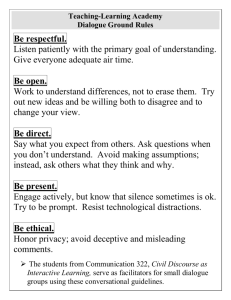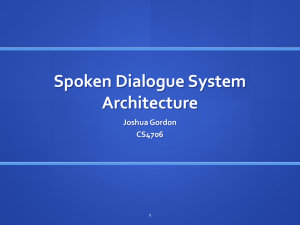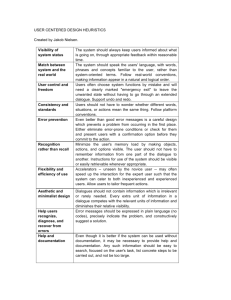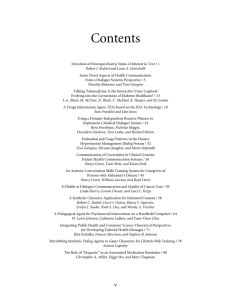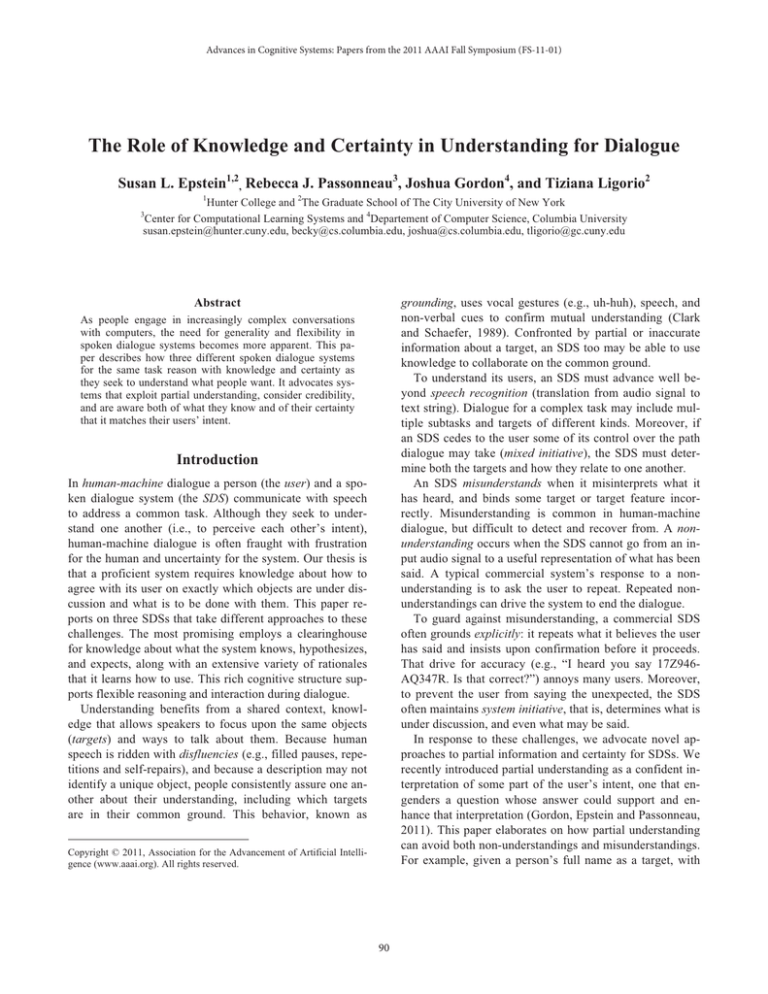
Advances in Cognitive Systems: Papers from the 2011 AAAI Fall Symposium (FS-11-01)
The Role of Knowledge and Certainty in Understanding for Dialogue
Susan L. Epstein1,2, Rebecca J. Passonneau3, Joshua Gordon4, and Tiziana Ligorio2
1
Hunter College and 2The Graduate School of The City University of New York
Center for Computational Learning Systems and 4Departement of Computer Science, Columbia University
susan.epstein@hunter.cuny.edu, becky@cs.columbia.edu, joshua@cs.columbia.edu, tligorio@gc.cuny.edu
3
grounding, uses vocal gestures (e.g., uh-huh), speech, and
non-verbal cues to confirm mutual understanding (Clark
and Schaefer, 1989). Confronted by partial or inaccurate
information about a target, an SDS too may be able to use
knowledge to collaborate on the common ground.
To understand its users, an SDS must advance well beyond speech recognition (translation from audio signal to
text string). Dialogue for a complex task may include multiple subtasks and targets of different kinds. Moreover, if
an SDS cedes to the user some of its control over the path
dialogue may take (mixed initiative), the SDS must determine both the targets and how they relate to one another.
An SDS misunderstands when it misinterprets what it
has heard, and binds some target or target feature incorrectly. Misunderstanding is common in human-machine
dialogue, but difficult to detect and recover from. A nonunderstanding occurs when the SDS cannot go from an input audio signal to a useful representation of what has been
said. A typical commercial system’s response to a nonunderstanding is to ask the user to repeat. Repeated nonunderstandings can drive the system to end the dialogue.
To guard against misunderstanding, a commercial SDS
often grounds explicitly: it repeats what it believes the user
has said and insists upon confirmation before it proceeds.
That drive for accuracy (e.g., “I heard you say 17Z946AQ347R. Is that correct?”) annoys many users. Moreover,
to prevent the user from saying the unexpected, the SDS
often maintains system initiative, that is, determines what is
under discussion, and even what may be said.
In response to these challenges, we advocate novel approaches to partial information and certainty for SDSs. We
recently introduced partial understanding as a confident interpretation of some part of the user’s intent, one that engenders a question whose answer could support and enhance that interpretation (Gordon, Epstein and Passonneau,
2011). This paper elaborates on how partial understanding
can avoid both non-understandings and misunderstandings.
For example, given a person’s full name as a target, with
Abstract
As people engage in increasingly complex conversations
with computers, the need for generality and flexibility in
spoken dialogue systems becomes more apparent. This paper describes how three different spoken dialogue systems
for the same task reason with knowledge and certainty as
they seek to understand what people want. It advocates systems that exploit partial understanding, consider credibility,
and are aware both of what they know and of their certainty
that it matches their users’ intent.
Introduction
In human-machine dialogue a person (the user) and a spoken dialogue system (the SDS) communicate with speech
to address a common task. Although they seek to understand one another (i.e., to perceive each other’s intent),
human-machine dialogue is often fraught with frustration
for the human and uncertainty for the system. Our thesis is
that a proficient system requires knowledge about how to
agree with its user on exactly which objects are under discussion and what is to be done with them. This paper reports on three SDSs that take different approaches to these
challenges. The most promising employs a clearinghouse
for knowledge about what the system knows, hypothesizes,
and expects, along with an extensive variety of rationales
that it learns how to use. This rich cognitive structure supports flexible reasoning and interaction during dialogue.
Understanding benefits from a shared context, knowledge that allows speakers to focus upon the same objects
(targets) and ways to talk about them. Because human
speech is ridden with disfluencies (e.g., filled pauses, repetitions and self-repairs), and because a description may not
identify a unique object, people consistently assure one another about their understanding, including which targets
are in their common ground. This behavior, known as
Copyright © 2011, Association for the Advancement of Artificial Intelligence (www.aaai.org). All rights reserved.
90
recognition confidence high for the last name but low for
the first, a traditional SDS might re-prompt for the full
name or signal non-understanding. Partial understanding
would engage the user in a subdialogue that grounds the
last name, and then elicits a first name consistent with the
database and similar to the poorly-recognized first name.
We describe three SDSs for the same task: book orders
at the Heiskell Braille and Talking Book Library, part of
the New York Public Library and the Library of Congress.
Heiskell’s patrons order their books by telephone and receive them by mail. Book requests are by title or author, as
often as by catalog number. All three SDSs have ample
procedural knowledge about communication and dialogue.
They know that speakers should take turns, and that listening provides a continuous audio signal, only some of which
should be regarded as speech. They know that speech signals can be mapped to phonemes, and that only some sequences of phonemes are meaningful (known words). They
know too that relevant word sequences provide possible
bindings for targets or for indicators (e.g., yes, no).
To understand and respond to spoken input, commercial
SDSs and applications where dialogue is subsidiary often
rely on a pipeline architecture. A pipeline does best with
well-recognized utterances about one class of objects over
a limited vocabulary. In contrast, our library task is noteworthy for its confusability (e.g., the same name could be a
patron, a title, or an author), its unusually long and complex responses (e.g., average title length of 6.4 words), and
its scale: 5000 patrons plus a vocabulary of 54,448 words
drawn from 71,166 books by 28,031 authors. Moreover,
book titles are more like unrestricted language than like
structured data, and more difficult to understand. This task
also challenges automated speech recognition (ASR) with
users’ diverse native language, and with transmission noise
and background noise in the audio signal. The next section
describes the pipeline. Subsequent sections describe our
three SDSs for the library task, explain how they differ in
their use of knowledge and certainty, and focus on grounding. Finally, we discuss results and future work.
are mapped to concepts by the subsequent natural language
understanding (NLU) process. If the initial endpointing is
not semantically coherent, the IM can override it (e.g.,
combine two speech segments into one utterance).
To transcribe the speech signal into text, the ASR relies
on an acoustic model that maps speech sounds to phonemes, a lexicon that maps phoneme sequences to words,
and a language model that indicates the probabilities of sequences of n words. The ASR forwards its output to a semantic parser, where a concept is an attribute of an object
(e.g., a book’s title). The parser tries to associate a given
ASR text string with one or more concepts, and can skip
words that cannot be parsed. A confidence annotator then
selects at most one best parse.
The pipeline forwards that parse with its confidence to
the SDS’s dialogue manager. Given a confident parse, the
dialogue manager performs one or more optional queries
to backend databases, followed by a command to the natural language generator (NLG). For example, if the best
parse indicated that the utterance was a book title, the dialogue manager could query the book database for similar
titles, and then direct the NLG to formulate text to confirm
the most similar (e.g., “Did you want Jane Eyre?”). The
NLG forwards that text to the text-to-speech module,
which in turn forwards the speech it generates to the interaction manager for transmission to the audio manager and
then to the user. Given an unconfident parse or none at all,
the dialogue manager invokes error handling appropriate to
a misunderstanding or a non-understanding.
Errors may arise at many points in this pipeline. The
audio manager might improperly endpoint the speech signal, and the IM might be unable to correct it. The user’s
words might not be in the system’s lexicon. Disfluencies
might disrupt the structure of spoken dialogue (Jurafsky
and Martin, 2008). The ASR might mismatch signal to
phoneme, or phoneme sequence to words. Finally, even
with perfect speech recognition, a string might have a best
(or first) parse that is incorrect, or even no parse at all.
Understanding in Three SDSs
Knowledge and error in a pipeline
We have built three systems for the library task. The first
two are full SDSs that accept telephoned orders for up to
four books, and can reference copies of Heiskell’s entire
book and (sanitized) patron databases. During a call, each
dialogue addresses a sequence of subtasks: identify the
user as a known patron, accept book requests, and offer an
order summary. (Book requests are the most difficult.) Despite increasingly accurate ASR, deployed SDSs sometimes contend with word error rates (WER) as high as 68%
(Raux et al., 2005). The work reported here has a similar
WER to support research on strategies robust to poor ASR
We take as a pipelined model Olympus/RavenClaw, an
SDS architecture that has supported the development of
more than a dozen spoken dialogue systems (Bohus and
Rudnicky, 2009). When it detects voice activity in the incoming signal, such a system’s audio manager labels and
segments it into frames (short intervals of signal analysis
output), and judges when the user began and stopped
speaking (endpointing). It forwards the frames to an interaction manager (IM) that determines whether the user intends to continue speaking despite a pause. The IM also
supervises while text strings from the speech recognizer
91
The first SDS, CheckItOut, was developed with Olympus/RavenClaw modules. CheckItOut’s decisions rely on
PocketSphinx, a fast, efficient speech recognizer, and Wall
Street Journal acoustic models. From a randomly-chosen
subset of its database plus knowledge derived from its semantic grammar, CheckItOut generates both its lexicon
and its language models with the Logios language compilation suite. Although its Phoenix parser is already robust to
ASR noise, CheckItOut supplements it with productions
derived from MICA dependency parses of book titles
(Bangalore et al., 2009; Gordon and Passonneau, 2010). As
a result, it can parse even poorly recognized title strings.
Parses are scored by the Helios confidence annotator. The
RavenClaw dialogue manager supplies task-independent
error-handling mechanisms through a domain-dependent
dialogue task tree (described below).
The second SDS, CheckItOut+, is identical to the first
except for its dialogue manager, which models how people
solve the problems that confront the system. It relies on information from all stages of spoken language understanding (SLU) to override the pipeline at three key decision
points. While CheckItOut queries its database only when it
understands (i.e., has a single confident parse whose slots
match a known concept), CheckItOut+ queries with a full
ASR text string (voice search), without recourse to Phoenix or Helios. When CheckItOut does not understand, it
asks the user to repeat, but CheckItOut+ asks questions.
(Further details appear in the next section.) Finally, while
CheckItOut ends a call after several consecutive nonunderstandings, CheckItOut+ can move on, that is, ask the
user to request another book and return to this one later.
The third SDS, FX2, implements some of the functionality of a full system with modules built from FORR, a cognitive architecture for learning and problem solving
(Epstein, 1994). Rather than postulate a single decision rationale (e.g., voice-search confidence), a FORR-based system has Advisors, resource-bounded procedures that produce any number of comments. Each comment supports or
opposes one action with a strength that reflects that Advisor’s underlying rationale. (For example, comment strength
may reflect the degree to which a match is the same length
or sounds the same.) FX2 is built within FORRSooth, a
new SDS architecture with six FORR-based services, each
with its own set of heuristic dialogue Advisors. To make a
decision, a service solicits comments about possible actions from its Advisors, tabulates a weighted combination
of comment strengths that address each action, and identifies actions with high support. FX2 conducts selected subdialogues for the library task. FX2 also uses PocketSphinx
but, like CheckItOut+, it is more resourceful in its responses to partial understanding and non-understanding.
FX2 has a flexible dialogue representation, and a host of
rationales with which to reason about what is expected,
what it has hypothesized, and what has been said.
Noteworthy differences
An SDS should respond appropriately, effectively, and in
real time to its user’s speech. SDS performance is gauged
not only by success (task achievement) and cost to the user
(e.g., elapsed time), but also by user satisfaction, a nontrivial metric where faster and more accurate is not always
better (Walker et al., 1997). All differences reported below
are significant at the 95% confidence level under a t-test.
Before each call in the full SDS experiments reported
here, the user retrieved a randomly-generated assignment
from our website: a patron identity and data on four books.
The user was told to request one book by author, one by title, one by catalogue number, and one by any method of
her choice. (For a request by author, a query returns the
three books by that author with the highest circulation.)
Each experiment had 10 subjects make 50 calls each to the
SDS. In the FX2 experiment, users interacted with the system by microphone rather than telephone, and interactions
were subdialogues for a concept, such as author identity.
CheckItOut relies on matching
Even among many choices, people can ferret out an object
that corresponds to a speaker’s intent. Consider, for example, a book title the recognizer reported as SOONER SHEEP
MOST DIE. Our pilot study gave similarly noisy ASR for 50
book titles, a plain text file of the library’s 71,166 titles,
and unlimited time offline, to each of 3 subjects
(Passonneau et al., 2009). They correctly matched 74% of
the ASR strings to a listed title.
CheckItOut matches such noisy ASR against its database with the Ratcliff/Obershelp similarity metric between
two strings (R/O score): the ratio of the number of correct
characters to the number of characters (Ratcliff and
Metzener, 1988). (For example, the R/O score for Robert
Lowell and ROLL DWELL is 0.61.) CheckItOut’s best
matches for SOONER SHEEP MOST DIE are Soon She Must
Die, Why Someone Had to Die, and The Messenger Must
Die. Clearly, the first is the intended book. Indeed, given a
single confident parse from noisy ASR for book titles (with
a WER of about 70%), the search return with the top R/O
score is the correct match about 65% of the time (Ligorio
et al., 2010). A skilled human, however, can achieve
85.5% accuracy at this task, as we shall see shortly.
When CheckItOut produces a single confident parse for
a title or an author, its dialogue manager searches for it in
the database with the parsed ASR words. It then offers the
user the return with the top R/O score, as in Figure 1. Although 65% accuracy is not satisfactory to people, another
6% of the time the correct match is elsewhere in the top 10
returns (Ligorio et al., 2010). For these cases CheckItOut+
and FX2 bring to bear additional knowledge already within
the system, but with very different approaches.
92
CheckItOut+ tries harder
had just occurred), the SLU (average ASR word confidence, number of words covered by the best parse, number
of parses for this ASR, whether this is the top grammar slot
in the best parse tree), and the number of author queries in
this request. Model O decides whether to offer a book,
based on whether or not this is a new request, the total
number of move ons, mean acoustic score, and mean and
standard deviation of the R/O scores. Finally, Model Q decides whether to ask the user a question given the number
of user utterances in this adjacency pair and features that
describe the current request: number of author queries for
it, number of partial explicit confirmations for it, maximum
ASR word confidence, overall acoustic model score,
whether there was a title slot in the best parse, the number
of words not covered by the best parse, and the confidence
in the best parse. Model Q also shares three features with
Model S: whether the current adjacency pair was initiated
by an explicit confirmation, average ASR word confidence, and number of author queries in this request.
CheckItOut+ improved task success. Throughput rose —
the number of ordered books increased from 3.22 with
CheckItOut to 4.00 per call, while the elapsed time per ordered book decreased from 65.57 to 56.01 seconds. Costs
rose too — the system spoke more, and the user had to
speak more often. Total elapsed time per call rose from
210.93 to 223.96 seconds, while the elapsed time per correct book decreased from 87.89 to 82.95. CheckItOut+
identified more books correctly on every call (2.70 instead
of 2.40), but it also got more wrong, which forced the user
to correct it more often.
To gauge user satisfaction, each subject completed the
same questionnaire about her experience with CheckItOut
or CheckItOut+ 3 times in the course of her 50 calls. Although their answers were consistent (Cronbach’s α = .97),
CheckItOut+ processes a single confident parse the way
CheckItOut does. In the absence of a single confident
parse, when CheckItOut would have signaled non-understanding, CheckItOut+ uses three learned models to advance the dialogue. If it has at least one ASR text string but
no confident parse, Model S (for search) decides whether
the most confident ASR text string is good enough to use
in voice search. If so, CheckItOut+ searches three times,
because the utterance might refer to a book by title, author,
or catalogue number. Model O (for offer) determines
whether to offer the return with the highest R/O score, or to
request additional information from the user. Otherwise, if
CheckItOut+ did not do voice search, it uses its Model Q
(for question) to decide whether to question the user about
another way to identify the book or merely to signal nonunderstanding. Figure 2(a) is an example of voice search;
Figure 2(b) is a request for further description.
CheckItOut+’s models are the result of logistic regression on 163 features available at runtime. The models are
based on data from an elaborate experiment that replaced
CheckItOut’s dialogue manager with an ablated wizard, a
person given the same input and query facility as the SDS,
and restricted to a limited set of dialogue acts. The models
were learned from system features and wizard actions
logged during 913 dialogues (Ligorio, 2011).
The knowledge embedded in these models supports a
different kind of dialogue. The only subject who had called
both CheckItOut and then, months later, called CheckItOut+, commented on the change: “This new system just
doesn’t let up on you.” CheckItOut+ is indeed persistent,
resulting in dialogue like Figure 2(b).
CheckItOut+’s models use 24 features in all, only 2 of
which (author and title queries) are library-specific. An adjacency pair is the portion of the dialogue from one system
prompt to just before the next one; it may include multiple
user utterances. Model S determines whether to search on
the ASR; its features describe the current book request
(number of adjacency pairs, number of database or title
queries for it), the dialogue (number of questions thus far),
the context (whether this adjacency pair was initiated by an
explicit confirmation, whether or not a non-understanding
(a) CheckItOut+: What's the next book?
ASR: .FOR. .NONDRIVERS. .SCHULLER. CHAPMAN
CheckItOut+: Is the author Fern Schumer Chapman?
ASR: YES
CheckItOut+: Would you like Motherland beyond the Holocaust: A Mother-Daughter Journey to Reclaim the Past?
ASR: YES
(b) CheckItOut+: What's the next book?
ASR: DUST .TO. DUNE
CheckItOut+: Is the title Dust to Dust ?
ASR: NO
CheckItOut+: Sorry, I misunderstood. Can you repeat the title
please?
ASR: GOING THE .OTHER. ARETHA THAT
CheckItOut+: Can you please give me the catalogue number?
ASR: THREE ONE NINE NINE EIGHT
CheckItOut+: Gorbachev: Heretic of the Kremlin. Got it!
CheckItOut: Sorry, I misunderstood. Can you repeat the author?
ASR: DIDN’T I AM THE .GOLDEN. ARM
CheckItOut: Is the title The Man with the Golden Arm?
ASR: NO
CheckItOut: Sorry, I misunderstood. Can you repeat the title
please?
ASR: .A. .AMBLING. .THE. .GAME. .EDELMAN. STORY
CheckItOut: Is the title Up and Running: The Jami Goldman
Story?
ASR: YES
Figure 2: CheckItOut+ dialogue fragments harness partial understanding despite unconfident ASR (delimited by periods). (a) Use
of voice search. (b) Request for further description.
Figure 1: Part of a CheckItOut dialogue. ASR is in uppercase.
93
there was only one significant difference: CheckItOut+ users more often indicated that they had to pay close attention while using that system, probably because this SDS
responds to partial understanding with a question, not a request to repeat. There was no statistically significant support, however, for user preference of one system over the
other, even though CheckItOut+ identified more books correctly and processed individual book requests faster.
records progress toward its grounding, as described below.
The graph retains partial understandings (e.g., a patron’s
perfectly recognized first name) between user utterances.
FORRSooth’s INTERPRETATION service constructs hypotheses (the system’s beliefs in possible values) for
agreement nodes. Each of its nine matching Advisors represents a different way to formulate a hypothesis about
what the user has said (Gordon, Passonneau and Epstein,
2011). Resources for them include Olympus modules, and
DoubleMetaphone representations of titles and authors.
One matching Advisor simulates CheckItOut; it proposes
top returns from a query based on Helios’ most confident
parse. Two Advisors do not search at all; they propose hypotheses based on the parse of either all confident words,
or all words, in the ASR. Another does voice search based
on concepts identified by all parses, and re-ranks the returns with strength proportional to the number of confident
words. Two pairs of Advisors use R/O score with voice
search in the database, against either the target values or
their DoubleMetaphone representations. One pair does
voice search in the title, author, and catalogue-number tables; the other pair searches them with the concatenated
terminals from the Phoenix parses. Finally, one uses parses
both to decide whether the request was a title, an author, or
a catalogue number, and to rank the search returns.
Comment strengths for voice-search Advisors are computed from such metrics as R/O score, ASR word-level
confidence, and relative position and edit distance between
the ASR and a search return. Comment strengths for parseoriented Advisors are based on overall and word-level confidence, and the number of words not covered by the parse.
The merit of a hypothesis gauges the extent to which Advisors’ comments support it over alternatives for that node.
Merit equals the percentile into which the (normalized)
strengths of the comments that support a hypothesis fall,
relative to others for the same node. Based on matching
Advisors’ comments, SATISFACTION records hypotheses
with their merits on the corresponding agreement nodes.
INTERPRETATION also has five merging Advisors that revise merit or formulate new hypotheses for a node from existing hypotheses for the partial information in its attribute
children. Based on R/O scores, two Advisors (one for patrons and one for authors) propose full name hypotheses
based on existing hypotheses for the first and last names.
Two others formulate hypotheses from fragments of titles
or telephone numbers with high R/O scores. The fifth
merging Advisor revises the merits of existing hypotheses
based on grounding status, described below. As with
matching, voting determines a single action to take. FX2’s
INTERPRETATION service produces relatively reliable hypotheses for patron names; their quality degrades gracefully as ASR performance declines (Gordon, Passonneau
and Epstein, 2011).
FX2 constructs a dynamic representation
As required by RavenClaw, CheckItOut’s dialogue manager is a task tree, a hierarchy of pre-specified dialogue
procedures (e.g., Login, in Figure 3(a)). Some leaf nodes
(e.g., Get area code) issue prompts to determine values for
concepts. The task tree is executed depth-first, but preconditions on nodes can redirect it. For example, Inform
lookup error will return control to Login if there is no
match on the telephone number. The task tree effectively
preprograms dialogue flow. (RavenClaw’s support for limited mixed initiative was not used here.) CheckItOut+ uses
the CheckItOut task tree if there is a confident parse, and
otherwise relies on its three models.
Instead of a static task tree, in a FORRSooth SDS the
SATISFACTION service maintains an agreement graph, a
dynamic structure that represents what is under discussion.
An agreement is a subdialogue to bind a target (e.g., the
first book in an order). Initially, an agreement graph node
represents a target or an attribute of a target as its child. An
example for author appears in Figure 3(b). Each node also
(a)
(b)
Figure 3: (a) Part of the task tree for CheckItOut. (b) A fragment
of an FX2 agreement graph for author name. First and last are attribute children; hypotheses appear with their respective merits.
The node on the left represents a decision to ground.
94
Weight Learning) algorithm to learn weights for FX2’s
GROUNDING and INTERPRETATION Advisors. Relative support for an action is the normalized difference between the
comment strength with which an Advisor supports an action and the strength with which it supports other actions.
RSWL reinforces Advisors’ weights in proportion to their
comment strengths (Petrovic and Epstein, 2007).
In FORRSooth, learning is currently offline, with training examples gleaned from the system’s independent dialogues, and labels from user-supplied indicators or from
wizard experiments. Because GROUNDING is essential to
exploit partial understandings, FORRSooth provides a
mechanism to extract preliminary training examples. In
wizard mode, while a user speaks with the SDS, a GUI
provides a human wizard with the SDS’s current hypotheses and merits for all targets. Each time the wizard chooses
whether to ground a target, and which grounding action to
use on it, a training example is logged.
FX2 begins with some prior knowledge about how to
use its Advisors well. For the baseline version we learned
preliminary INTERPRETATION weights on prerecorded development data. (A training example was a target with its
ASR and correct binding.) We gleaned training examples
for GROUNDING in wizard mode while 4 subjects made 30
calls to FX2, with hypotheses and merits produced under
those weights. Finally, we retrained FX2 on the development data and the new wizard-mode training examples extracted for both INTERPRETATION and GROUNDING, several
hundred examples in all (Gordon, Epstein and Passonneau,
2011). The resultant learned version of FX2 produced the
dialogue in Figure 4. The learned version virtually eliminates misunderstandings; it prefers to ground by disambiguation (52%) and repetition (32%), with occasional recourse to confirmation (15%) and other strategies (1%).
Four subjects had 30 subdialogues with the baseline version and 30 with the learned version. We evaluated the two
versions on subdialogues to bind either a book title or a patron name. The length of a subdialogue is measured here
by the number of times the system spoke. Length improved
from 4.36 in the baseline to 3.86 after learning. (In comparison, CheckItOut+ averaged length 6 for book titles.) If
a subdialogue identifies the requested object it is correct. If
Grounding supports understanding
In both CheckItOut and CheckItOut+, grounding behavior
is managed by Ravenclaw’s error-handling routines. When
Helios identifies a sufficiently confident parse, those systems search on it, and then offer the best query result to the
user. Both SDSs also retain at most one binding for a target
between user turns. In contrast, a FORRSooth-based SDS
entertains multiple hypotheses for agreement nodes, and
retains some hypotheses until a node is bound.
FORRSooth’s GROUNDING service monitors the merit
values on the agreement graph, relying on learned Advisor
weights (Gordon, Epstein and Passonneau, 2011). It proposes node values to the user, and elicits corroboration,
further information, or tacit agreement when it determines
that a hypothesis requires no confirmation from the user
(e.g., “Got it. Next book?”). These 23 Advisors reference
such additional information as ASR word confidence, how
long the dialogue has progressed, and whether a hypothesis
is for a target node or its child. They seek to advance the
dialogue with fewer questions and little chance of error.
For example, when a hypothesis for the last name agreement has very high merit but conflicts with an existing hypothesis for the first name of the same target, FX2 detects
the conflict and considers both hypotheses unconfident.
If GROUNDING cannot bind an existing hypothesis to its
target as a value, it considers how to discuss its uncertainty
with the user. A grounding agreement either elicits confirmation for a particular hypothesis or seeks to disambiguate between competing ones. A grounding agreement is attached to a target or to an attribute node whose hypothesis
it addresses. It has an expectation for its anticipated user
response, and it specifies a grounding action. Grounding
actions in FORRSooth include explicit confirmation (e.g.,
“Is the title Dust to Dust?”), implicit confirmation (e.g.,
“By John Wooden”), and disambiguation (e.g., “Was that
‘Jane’ or ‘John’?”). Based on hypotheses, their merits, and
expectations associated with grounding agreements, 23 additional FX2 GROUNDING Advisors determine when and
where to append a grounding agreement to the graph. They
consider, for example, whether there are competing hypotheses for the same target, if a hypothesis is for a title or
a subtitle, and if it is the first attempt to ground this node’s
value. In Figure 4, FX2 finds two promising but competing
hypotheses for the same target, and offers them to the user.
Although the response matches the grounding agreement’s
expectation, INTERPRETATION fails to understand the response, and FX2 tries a different grounding action.
FORRSooth is intended to learn rapidly to tailor an
SDS’s responses to its task. The weights a FORR-based
system uses to select an action are learned from labeled
training examples. A FORRSooth-based SDS learns one
set of weights for each service and each concept. We used
FORR’s domain-independent RSWL (Relative Support
FX2: What title would you like?
User: Family and Friends
ASR: FAMILY .FRIENDS.
FX2: I have two guesses. The first is Family and Friends. The
second is Family Happiness. Is it either of these?
User: The first one
ASR: .NEXT. .FIRST.
FX2: Let’s try something else. Is the full title Family and
Friends?
User: Yes
ASR: YES
Figure 4: Grounding behavior in an FX2 dialogue fragment, with
what the user actually said as well as what the system “heard.”
95
it identifies some object it is complete; otherwise it is incomplete. Precision is the ratio of correct to completed
subdialogues. Despite an estimated WER of 66%, precision rose with learning, from 0.65 in the baseline to a perfect 1.00 (n = 120) in the learned version. Recall is the ratio of correct subdialogues to correct plus incomplete subdialogues. Recall dropped somewhat with learning; it went
from 0.78 in the baseline to 0.71. Finally, F is the harmonic mean of precision and recall. F rose with learning,
from 0.72 in the baseline to 0.83 in the learned version.
The agreement graph also represents the conversational
state, that is, what dialogue utterances have contributed to
the current common ground with respect to task objects.
FX2 allows a new utterance to change an agreement graph
for a target already addressed by an earlier utterance. It periodically removes weak hypotheses, and makes decisions
based on the merits of those that remain.
Much of this work is task-independent, including merit,
RSWL, and the agreement graph. Indeed, 52 of FX2’s 60
INTERPRETATION and GROUNDING Advisors are provided
by FORRSooth. The other eight, intended only for names,
apply important ideas about the way attributes identify an
object uniquely. Current work generalizes them for other
concepts and other identifiers. Our best wizards’ problemsolving behaviors are also task-independent (and likely to
pertain to other cognitive systems as well): search before
you reply, disambiguate among likely search returns, and
notice when no match looks reasonable.
Our experiments made clear that people want an SDS
that is not only fast and effective, but also transparent and
easy to converse with. Users also need confirmation, so
that they know what the system believes. For example,
even when a wizard was both certain and correct, several
users complained that they were surprised at the end of the
call to hear that the order summary they had demanded actually included the correct books. FX2’s fine-grained
grounding provides more transparency than many SDSs
about how the common ground evolves.
FORRSooth extends FORR with parallel computation
and the ability to propose hypotheses, but it remains a
work in progress. FX2 is its first application, and some of
its services (an INTERACTION manager, GENERATION of
natural language, and DISCOURSE to focus of attention and
manage objects) are not yet implemented. SATISFACTION
requires further development.
Human expertise inspires and supports FORRSooth in a
variety of ways. To create Advisors and devise strengths
for their comments, we continue to mine both commentaries from subjects in the pilot study, and the features that
drive CheckItOut+’s models. A FORR-based system traditionally uses a three-tiered hierarchy of Advisors; some are
always correct, and others heuristically formulate behavior
sequences. Both kinds are a focus of current work for
every service. Subjects’ comments have also led to some
Advisors that oppose actions (e.g., do not ground) as well
as others that support them. There is even an INTERPRETATION Advisor that simulates an expert CheckItOut wizard.
Other cognitive architectures have also begun to address
dialogue. CogX retains the pipeline; its perceptron learns
to discriminate among the many more parses its relaxed
grammar rules produce (Lison and Kruijff, 2009). Current
work in SOAR uses written subdialogues to teach an apprentice goal-oriented plans using an extendible, but thus
far small, vocabulary (Assanie and Laird, 2011).
Discussion
Our three SDSs all rely on the same speech recognizer and
databases, but FX2 uses them with considerably more success. CheckItOut+ monitors its pipeline, and behaves differently when it believes an error has arisen. FX2 employs
a variety of rationales observed in human behavior during
our pilot study and our wizard experiment, and learns to
balance them, instead of pre-specifying their interaction.
Two of our systems take novel approaches to the role of
certainty in SDS decision making. CheckItOut+ includes
system-component confidence values and other metrics on
performance accuracy (e.g., number of questions) to select
its actions. Its models recognize when CheckItOut+ has a
partial understanding, when it has a reasonable guess, and
when it should seek another way to identify a target. These
models are procedural metaknowledge learned from features for components where SDS developers know that errors are likely to arise. In contrast, FX2 scales certainty as
merit, and represents partial information explicitly. It links
targets in its agreement graph with plausible values, and
formulates grounding behaviors for strong hypotheses. The
agreement graph is a clearinghouse for commentary on
what may or may not have been intended by the user, as
construed by FX2’s Advisors. In this way, FX2 harnesses
partial understanding and multiple perspectives to match
spoken input and domain knowledge to targets.
Some of this work has appeared in venues for natural
language processing, human cognition, or system design.
Here, we have sought to compare and analyze it, primarily
to clarify the role of knowledge and certainty in understanding during dialogue. Task-specific knowledge about
objects often provides contextual data against which to
match accurate input. Two SDSs here, however, use contextual data to generate plausible hypotheses from imperfect input. One learns models of human decision making from thousands of instances. The other learns to combine many rationales that were effectively gleaned from a
few hundred instances of human behavior. FX2’s rationales propose hypotheses, gauge their accuracy, and may
confirm them with the user. They are knowledge about
how to match and how to work toward common ground.
96
A machine’s context, however, is not a human one. We
do not restrict FORRSooth to reasoning mechanisms and
behaviors evidenced by people. After all, an SDS does not
have the world and social knowledge that people do.
FORRSooth’s Advisors also capture the perspective of the
system. For example, one INTERPRETATION Advisor, before
any database query, relies on a learned classifier to remove
from the ASR tokens likely to correspond to noise.
Whether or not people do this, an SDS certainly should.
References
Assanie, M. and J. Laird. 2011. http://www.eecs.umich.edu/
~soar/sitemaker/workshop/19/assanie-FinalWorkshop.pdf.
Bangalore, S., P. Bouillier, A. Nasr, O. Rambow and B. Sagot
2009. MICA: a probabilistic dependency parser based on tree insertion grammars. Application Note. Human Language Technology and NAACL. Boulder, CO: 185-188.
Bohus, D. and A. I. Rudnicky 2009. The RavenClaw dialog management framework: Architecture and systems. Computer Speech
and Language 23(3): 332-361.
Clark, H. H. and E. F. Schaefer 1989. Contributing to discourse.
Cognitive Science 13: 259-294.
Epstein, S. L. 1994. For the Right Reasons: The FORR Architecture for Learning in a Skill Domain. Cognitive Science 18(3):
479-511.
Gordon, J., S. L. Epstein and R. Passonneau 2011. Learning to
Balance Grounding Rationales for Dialogue Systems. In Proceedings of SIGDIAL 2011.
Gordon, J. and R. Passonneau 2010. An Evaluation framework
for Natural Language Understanding in Spoken Dialogue Systems. In Proceedings of Seventh International Conference on International Language Resources and Evaluation (LREC '10),
European Language Resources Association.
Gordon, J., R. Passonneau and S. L. Epstein 2011. Helping
Agents Help Their Users Despite Imperfect Speech Recognition.
In Proceedings of AAAI Symposium Help Me Help You: Bridging the Gaps in Human-Agent Collaboration. AAAI Press.
Jurafsky, D. and J. H. Martin 2008. Speech and Language
Processing, 2nd edition. New Brunswick, NJ. Prentice Hall.
Ligorio, T. 2011. Feature Selection for Error Detection and Recovery in Spoken Dialogue Systems. Ph.D. diss., Department of
Computer Science, The Graduate Center of The City University
of New York, New York, NY. Ph.D. thesis.
Ligorio, T., S. L. Epstein, R. Passonneau and J. Gordon 2010.
What You Did and Didn’t Mean: Noise, Context, and Human
Skill. In Proceedings of Cognitive Science – 2010.
Lison, P. and G.-J. M. Kruijff 2009. Robust processing of situated
spoken dialogue. 3In Proceedings of 2nd German Conference on
Artificial Intelligence (KI '2009).
Passonneau, R. J., S. L. Epstein, J. B. Gordon and T. Ligorio
2009. Seeing What You Said: How Wizards Use Voice Search
Results. In Proceedings of IJCAI-09 Workshop on Knowledge
and Reasoning in Practical Dialogue Systems, Pasadena, CA,
AAAI Press.
Petrovic, S. and S. L. Epstein 2007. Random Subsets Support
Learning a Mixture of Heuristics. In Proceedings of FLAIRS
2007, Key West, AAAI.
Ratcliff, J. W. and D. Metzener 1988. Pattern Matching: The Gestalt Approach, Dr. Dobb's Journal.
Raux, A., B. Langner, A. Black and M. Eskenazi 2005. Let's Go
Public! Taking a spoken dialog system to the real world. In Proceedings of Interspeech 2005(Eurospeech), Lisbon, Portugal.
Walker, M. A., D. Litman, J., C. A. Kamm and A. Abella 1997.
PARADISE: A Framework for Evaluating Spoken Dialogue
Agents . In Proceedings of Thirty Fifth Annual Meeting of the
Association for Computational Linguistics (ACL), 271-280.
Conclusion
As we demand more of them, SDSs will find it increasingly difficult to understand their users. Future SDSs will
have to detect and address subtasks, and consider how
speech about attributes of objects can be exploited to identify those objects with certainty. People, meanwhile, will
continue to expect the efficient, virtually error-free performance traditional SDSs now produce when they receive
short utterances from a limited vocabulary.
CheckItOut+ models, to some extent, how people make
the kinds of decisions an SDS must make. Some of its
models’ features reference dialogue history, but it retains
no partial information from one adjacency pair to the next.
Making decisions like a person proves to be less effective
than FX2’s ability to collaborate with the user on the
common ground, and thereby minimize misunderstandings.
Nonetheless, the features behind human decisions are a
rich, task-independent resource for dialogue decision rationales, one that FORRSooth exploits to its advantage.
FX2’s agreement graph is a dynamic representation of
what it believes the user meant across multiple utterances,
and its certainty in that information. It begins as a model of
the task (a set of targets to be bound), but rapidly becomes
a representation of what the system suspects, what it has
confirmed, and what remains to be determined. The
agreement graph makes it possible to tell the user what the
system “thinks” (as in Figure 4), and FORRSooth’s Advisors can explain why it thinks so (e.g., “this sounds like the
first name and is similar to the last name”). FORRSooth’s
services and most FX2 Advisors are task-independent procedures that capture a broad range of reasons to consider
something a good match or worthy of consideration for
binding. Together they use knowledge and certainty to
support understanding with precision as good, or better
than, the best of our human wizards.
Acknowledgements
The National Science Foundation supported this work
under awards IIS-084966, IIS-0745369, and IIS-0744904.
97



